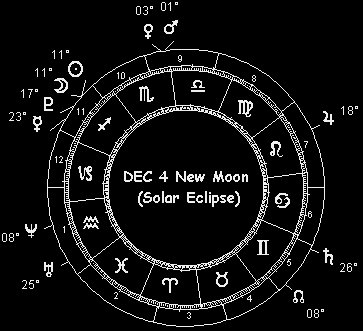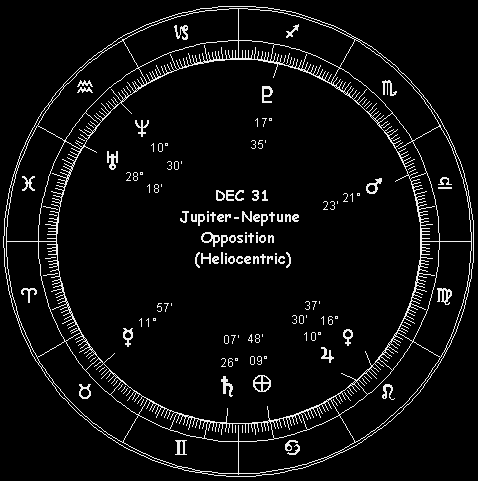If you were expecting some kind of sun sign nonsense, forget it. This is real astrology. See the section above. Please note: this forecast is expressed in terms of Universal Time (UT).
The solar eclipse at 12 Sagittarius is exact on December 4 (Universal Time), but already in effect by orb as the month begins. As noted in last month's forecast, in fact, storms and seismic action associated with this new moon eclipse would already be making headlines as of November 29. It'll take until the 11th before the solar eclipse effect wears off. As with all eclipses, this one is worldwide in terms of an increased risk for strong storms, flooding and moderate to severe seismic activity (including Richter 5+ quakes and volcanic eruptions). Global scope notwithstanding, there are some astro-locality indications that Hawaii and Alaska are in the crosshairs this time around; along with a north-south zone running from the tip of South Africa up through eastern Europe; also the Plains States, the India-Pakistan-Afghanistan-Iran region, and eastern Australia. Given that the Africa-to-Australia region includes the zone of visibility for this eclipse, you can figure these will be prime target areas.
 This eclipse, as I noted long ago, falls right on the ascendant in the US Declaration of Independence chart and belongs to the Saros Cycle 142 sequence, which began in 1624 - a time when European nationalism and colonialism were laying the foundations for much of today's geopolitics; also a time when a new dynasty was established in Russia, with the advent of the first of the Romanovs. The connection nationalism and colonialism have with the current conflict between the West and the rest of the world is evident to anyone who has the slightest acquaintance with history. The so-called "war on terrorism" is in reality just another Crusade. It won't be over in our lifetime, even if it does fade away from time to time. And it's likely to start cranking up to the next level of conflict around the time of the December 4 eclipse. The peaks of violence aren't due until around January 13 and February 4 (when Mars aligns with the November 27 and December 4 eclipse points), but events surrounding December 4 are sure to prime the pump in a big way.
This eclipse, as I noted long ago, falls right on the ascendant in the US Declaration of Independence chart and belongs to the Saros Cycle 142 sequence, which began in 1624 - a time when European nationalism and colonialism were laying the foundations for much of today's geopolitics; also a time when a new dynasty was established in Russia, with the advent of the first of the Romanovs. The connection nationalism and colonialism have with the current conflict between the West and the rest of the world is evident to anyone who has the slightest acquaintance with history. The so-called "war on terrorism" is in reality just another Crusade. It won't be over in our lifetime, even if it does fade away from time to time. And it's likely to start cranking up to the next level of conflict around the time of the December 4 eclipse. The peaks of violence aren't due until around January 13 and February 4 (when Mars aligns with the November 27 and December 4 eclipse points), but events surrounding December 4 are sure to prime the pump in a big way.
An eclipse on the US ascendant, with Uranus simultaneously transiting the Moon in the national chart, and Saturn nearing a retrograde alignment with the national Mars: what to make of such a combination? Weakness in the housing market, another surprise terror attack in the offing, a military conflict abroad . . . what else is new? We all see it coming, and the various planetary alignments point to late January-early February as the time when the dogs of war are loosed - on both sides. Could the kind of reexamination of national goals, strategy and tactics suggested by the December 4 eclipse turn conflict aside? We can hope . . . but I wouldn't bet on it.
Jupiter's retrograde station at 18 Leo takes place within just a few hours of the December 4 eclipse. The statesmen and diplomats are becoming irrelevant, and the market rally I predicted beginning shortly after October 6 and carrying the Dow to 10,000 by year's end ought to be well on track. It'll get a little wobbly from here to year's end, but the over-all trend should remain up until the escalation of hostilities in the Persian Gulf in late January or early February. Remember: there's been an air war ongoing over Iraq for years, and an accelerated one at that - as predicted - since early October. But that's just skirmishing in advance of the real deal.
 Meanwhile, back in the natural world, no sooner do the storms and seismic events start settling back to normal after the eclipse effect fades on the 11th, than another upsurge in storm and seismic activity sets in from the 12th through the 14th, a day either side of Luna's December 13 northward equatorial crossing. (It looks like the 12th and 13th are most vulnerable to geophysical upheaval.)
Meanwhile, back in the natural world, no sooner do the storms and seismic events start settling back to normal after the eclipse effect fades on the 11th, than another upsurge in storm and seismic activity sets in from the 12th through the 14th, a day either side of Luna's December 13 northward equatorial crossing. (It looks like the 12th and 13th are most vulnerable to geophysical upheaval.)
The next window of vulnerability to notable geological and meteorological upheaval is in effect from the 16th through the 22nd, associated with the December 19 full moon at 28 Gemini and the lunar north declination peak the following day. For an ordinary full moon - i.e., neither an eclipse nor a SuperMoon - this one ushers in an unusually high potential for flooding, storms and seismic activity (including Richter 5+ earthquakes and volcanic eruptions). High winds, hail, heavy wet snow, power outages and the like (due to wind and heavy precipitation) are a likely calling card of this kind of alignment. People snowed in and cut off from the world . . . and on Wall Street, some profit taking.
A period of lesser storm and seismic activity sets in after this full moon outburst, but the Earth's crust and atmosphere will be stirring up again late in the month. It starts on the 26th, a day in advance of the Moon's southward equatorial crossing. And it continues clean through the end of the month, what with the lunar perigee on the 30th and the new moon effect kicking in the same day.
Speaking of the month closing out, if you're in a position to take profits on equity investments, you'll probably be wise to do it before the heliocentric Jupiter-Neptune opposition on the 31st. (There'll be another buy-in opportunity in late January or early February.) Slowly at first, but with gathering speed as Jupiter repeats its geocentric opposition to Neptune in February and June 2003, inflation creeps back into the financial system. Late December 2002, under the aegis of the heliocentric version of this alignment, gives just an inkling of what is to come in this regard.
 SPECIAL FEATURE: This month's birthdays of the famous and infamous (with astrological birth charts)
SPECIAL FEATURE: This month's birthdays of the famous and infamous (with astrological birth charts)
